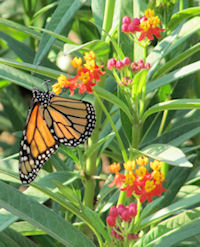The Monarch butterfly is one of North America’s most iconic insects. The gorgeous golden brown and black butterfly is probably the most celebrated insect on the continent, and the migration of the eastern population is spectacular. Southbound Monarchs can appear anywhere, even in highly urbanized locales, and the butterflies often use backyard gardens as way stations. Occasionally a resting swarm of hundreds or even thousands of butterflies is a spectacle unlikely to be forgotten.

Depending on the length of the season, which is dictated by the weather, Monarchs might have from two to four different broods in Ohio. The adults produced from the last hatch will make an incredible journey to high elevation fir forests in central Mexico. Once in Mexico, the butterflies congregate in massive numbers in a very few favored locations. Northward migration reaches the U.S. in early March. Females lay eggs on emerging milkweeds in the southern half of the U.S. The offspring of this first brood then colonize the north eastern region of U.S.
Monarchs depend on milkweeds as host plants. The butterflies deposit eggs on milkweed plants, which then provide nutrition for the caterpillar phase of the butterfly’s life cycle. Monarch caterpillars have evolved the ability to assimilate milkweed toxins. As the caterpillars, and subsequently the butterflies, sequester these toxic compounds in their bodies, they become distasteful to many predators.
When building a Monarch nursery garden, there are five species that Monarchs seem especially attracted to for egg laying purposes. All are fairly easy to grow, attractive and available in the native plant trade. 1.) Butterfly-Weed is a native Ohio plant with bright orange flowers that are a magnet for all manner of pollinating insects. 2.) Common Milkweed has aromatic flowers that exude a powerfully sweet scent that can be detected many feet away. This is the most frequently seen species in the state, and occurs in every county in the state of Ohio. It spreads rather aggressively, so gardeners may need to rein it in. 3.) Purple Milkweed has a gorgeous magenta flower that cannot be matched by any other. The blooming period is typically in June and July and attracts a variety of moths, as well. 4.) Sullivant’s Milkweed is a true prairie species discovered west of Columbus, Ohio in the 1840’s. It is the handsomest plant in the family, and lends itself well to prairie gardens and milkweed plots. 5.) Swamp Milkweed is the only wetland milkweed and will flourish along pond margins or other damp sites. It grows well in rich, well-drained soils of garden.
MILKWEED poisoning occurs frequently in sheep and cattle and occasionally in horses. Most livestock losses are a result of hungry animals being concentrated around milkweed-infested corrals, bed grounds, and driveways. Poisoning also may occur if animals are fed hay containing large amounts of milkweed. Dosages of milkweed as low as 0.1 % – 0.5% of the animal’s body weight may cause toxicity and, possibly, death. Cattle, sheep and horses are most susceptible. Toxicity is not lost when the plant is dried. Therefore, contaminated hay is potentially toxic. And it is because of this toxicity you will see the dreaded milkweed being hand pulled from my hayfields at hay making time!
Information gathered from the Ohio Department of Natural Resources Division of Wildlife